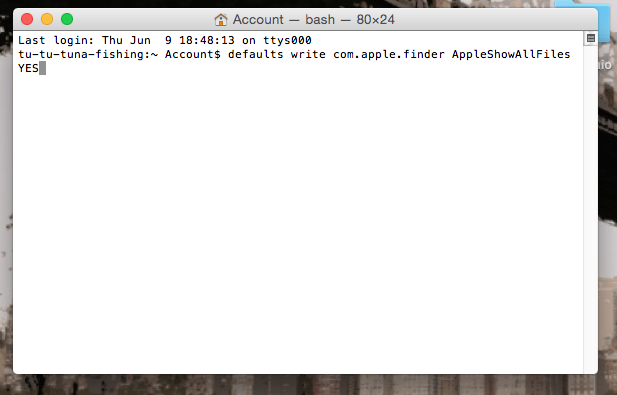
- #Mac terminal commands show hidden files how to
- #Mac terminal commands show hidden files full
- #Mac terminal commands show hidden files mac
Type this in terminal alias showme='defaults write AppleShowAllFiles YES killall Finder’ To create temporary alias for show and hide command do this: Note: In this guide, I will only share the process of creating temporary alias as the process of creating permanent alias is little bit complex and not suitable for beginners. bash_profile file to record permanent aliases. On the other hand, permanent alias lasts forever, you need to edit. As the name suggests the temporary aliases lasts for the current terminal session, they are vanished as soon as you close the terminal, however you can use them any number of times until the terminal is not closed. There are two types of aliases: temporary and permanent. This way you can run the command by just typing alias name. To simplify this process you can create aliases, they are just shortcuts to your command line commands that your write on terminal, so instead of writing the whole command every time you can create an alias for your command. What to do when you need to switch between show and hide frequently? Use Aliasesįor those who wants to switch between show and hide often, writing these commands again and again could be irritating. defaults write AppleShowAllFiles -bool False killall Finder If you want to go back to hide your hidden files then you can do so by typing following command. Hide hidden Files in Finder using Terminal Now you can see hidden files in finder.

#Mac terminal commands show hidden files how to
Later, in this guide we will also see how to create aliases to make things faster so that the users can quickly show and hide hidden files. All you need to do is type a simple command in terminal.

#Mac terminal commands show hidden files mac
You can also check out our separate how-to guide on revealing the hidden library folder in macOS.In this guide we will see how to show or hide hidden files in Mac OS. To switch the files back to hidden, simply change " YES" to " NO" in the Terminal command.

Once you've typed the command and pressed Enter, hold down the Option key, then right-click on the Finder icon in the Dock and click Relaunch for the changes to take effect. If you're comfortable using Terminal, entering the following command will also reveal all the hidden files on your Mac:ĭefaults write AppleShowAllFiles YES This action works everywhere except for the Desktop, and you can hide the affected files and folders again simply by repeating the key combo. The easiest way to reveal hidden files and folders in an active Finder window is to press the Shift, Command (⌘), and period symbol (.) keys in combination. Occasionally however, you might need to reveal these files and folders to fix a problem you're having with your Mac.
#Mac terminal commands show hidden files full
These are often preceded by a full stop or a slash, and are kept out of sight of the user either to prevent them from being deleted because they perform some essential function, or because they're irrelevant to everyday tasks. All Mac systems contain hidden files and folders.


 0 kommentar(er)
0 kommentar(er)
